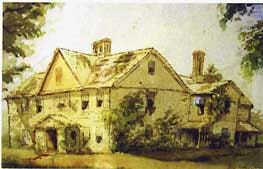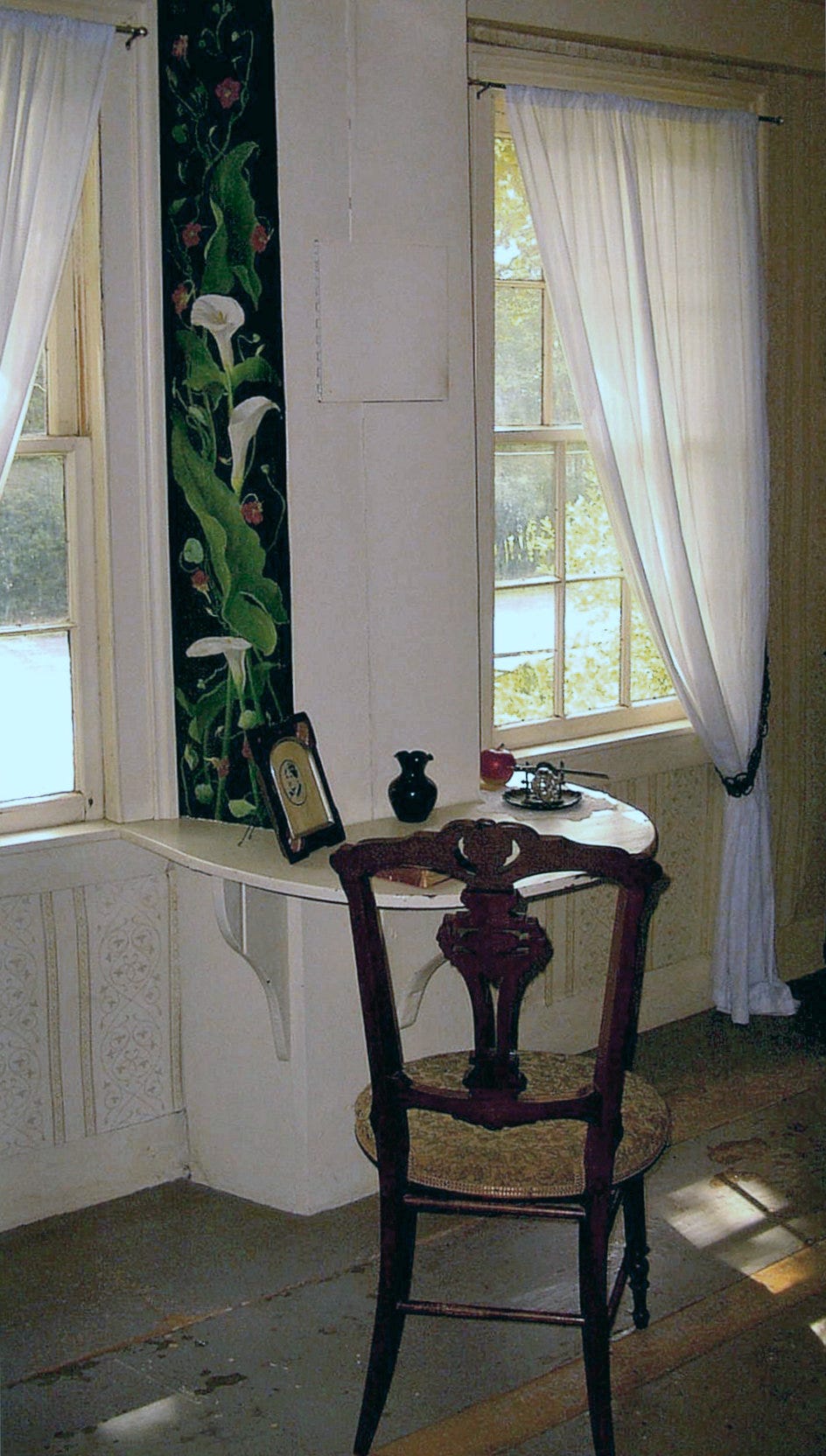No readers, I have not stopped reflecting on Little Women, and like many others I recently made the pilgrimage to the site of the story’s inception: Orchard House in Concord, Massachusetts where Louisa May Alcott and her sisters grew up.

Orchard House, watercolor by Abigail May Alcott.
When I arrived, I anticipated a tour that taught me about the author and her upbringing, and gave me the opportunity to see the famous desk where she wrote the entirety of Little Women.
Days later, the person on my mind is not Louisa, but instead her youngest sister, the artist in the house. Abigail May Alcott, who went by May, left a physical presence that persists to this day.
"Every piece of art in the house that is not a family portrait, was done by May," our tour guide told us.
Her art is everywhere. Oil paintings hang from nearly every room and every corridor — lush still lifes, landscapes, and pastoral snapshots. The walls of her old bedroom remains covered in pencil sketches — little figure drawings line both window frames, larger vignettes cover otherwise blank surfaces around the room, above the fireplace and behind doors. In the makeshift studio downstairs, she captured profile-view portraits of her visitors against the walls.
When Louisa fell ill with typhoid while serving as a nurse for the Union during the Civil War, May painted a spray of calla lilies alongside the window that her sister could see from her bed. It too is preserved and still vibrant, and it hovers over the very desk that Louisa would later write Little Women from.

Calla Lilies, Abigail May Alcott.
A neighbor to the Alcotts was concerned that his son was not paying attention in classes, not participating in male pursuits like sports, but instead spending all of his time carving fruits and vegetables. So he sent him to the Alcotts, where May oversaw his early explorations of sculpture and encouraged him to pursue the medium. Daniel Chester French would later go on to create The Minute Man, Alma Mater at Columbia University, and finally the statue of Abraham Lincoln at Lincoln Memorial.
Amy March, the youngest sister in the Little Women novel, has long been perceived as irritating, bratty. And to be fair, the character burns the manuscript of the book Jo's working on, which is actually horrifying. But one of the things that many viewers have pointed out about the most recent movie is how it is far more empathetic towards Amy, and casts her aspirations and goals in a compassionate light.
Little Women was not an autobiography, but it does pull from Louisa May Alcott's life in significant ways. I think about how maligned and misunderstood the figure of the littlest sister has been all these years, when in fact her real-life inspiration was clearly a creative in her own right. I wonder if the care and attention Greta Gerwig pays Amy in her movie is a way to honor what she too discovered about May when she visited Orchard House.
It brought me joy to learn later that May not only went on to study art in Europe (made possible due to the proceeds from Little Women) and made a career for herself as an artist, but also wrote a book so reflective of the pursuit of creativity that it’s relevant nearly a century and a half after its publication: Studying Art Abroad, and How to do it Cheaply, in which she points out the harsh economic realities behind being an artist.
It’s next up on my reading list. Thank you May Alcott.
Recommendations
- Video: Jerry from Cheer at the Oscars Red Carpet. If you watched Cheer (and if you haven't watched it, you should — it’s a six-episode documentary about Navarro College's cheer team available on Netflix), you'll love this clip.
- How Birds of Prey Director Cathy Yan Saved Harley Quinn From Joker and the Male Gaze. This movie was a delight (like, “Wow, that was actually a good DC movie” delight), and it was even more delightful to read that behind the camera, Birds of Prey featured a female director of Chinese descent and a female screenwriter of Taiwanese descent (Christina Hodson, who also wrote “Wow, that was actually a good Transformers movie” movie Bumblebee).
- Miss Americana on Netflix. I loved this. I don't care that it's a vanity documentary. It shows how Taylor Swift came to find her political voice, why she struggled to express it for so long, and the ways in which the things that happened to her (being interrupted during her acceptance speech at the 2009 VMAs, being groped in front of cameras, being vilified for existing as a pop star) radicalized her politics, in a similar way that those revelations came to many of us.
- In the Dream House. I attempted unsuccessfully to attend Carmen Maria Machado's book event while she was in the Bay Area because the line was out the door, and now I understand why. I read this entire memoir in one evening. It is haunting, and is also an incredible work of writing. Her grasp of genres and her vulnerability in recounting traumatic events in her past is astounding, and I am in awe of what she was able to accomplish here. An example with a mild spoiler warning: this memoir recounts an abusive relationship, and in one of the sections, she uses the Choose Your Own Adventure format to demonstrate the loop she found herself stuck in, unable to escape what she knew was toxic and dangerous.
Happy Valentines’ Day. Find love and kindred spirits in all of your relationships today and all days, and thanks for reading. <3


